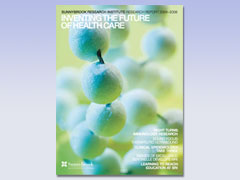Clinical Epidemiology: Take Three
Dr. Don Redelmeier wants you to get real.
He wants you to realize that the work that gets him up every morning, that inspires him to grab a peach and a can of Diet Black Cherry Vanilla Coke and to step lightly over the papers stacked on his office floor so he can reach his chair and put his feet up on his desk, is sincere. No pin-head-dancing angels here. Not even any astrophysics or subatomic stuff. Nope. Clinical epidemiology, he'll tell you, is science anchored in the real world.
"It's got to do with washing your hands before surgery, or buckling up in an automobile so you won't need surgery in the first place," says Redelmeier, who is director of clinical epidemiology at Sunnybrook Research Institute (SRI). "My favourite definition of clinical epidemiology calls it the science that evaluates the causes and consequences of disease in humans. If you're a bunny rabbit, we don't care about you. If you're a person who is suffering, you've got our attention."
Most people, Dr. Kathleen Pritchard laments, don't know what clinical epidemiology is. Tracing a finger along the words, this other prominent member of SRI's clinical epidemiology team at the Toronto Sunnybrook Regional Cancer Centre (TSRCC) gives a textbook explanation a go. "The practice of epidemiology that begins in a clinical setting," she says, reading aloud from A Dictionary of Epidemiology.
But it's only become an established term in the last generation, this amorphous concept, taking shape as a formal discipline distinct from epidemiology as a whole. Receiving training in it, says Dr. Linda Rabeneck, a senior scientist at the TSRCC and Sunnybrook's vice-president of regional cancer services, means having a box whose tools are portable and applicable. "If you decide tomorrow that you want to work on HIV, you can, because you have the training and the concepts. It's a way of thinking."
- Redelmeier: SRI scientist gives cholesterol-reducing drug new life in defence against sepsis.
- Rabeneck: Rabeneck puts colonoscopies under microscope.
- Pritchard: Cancer doc works to customize treatment—with a little help from her friends.



